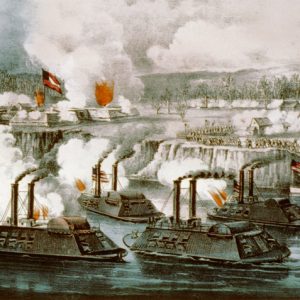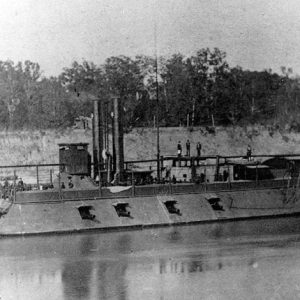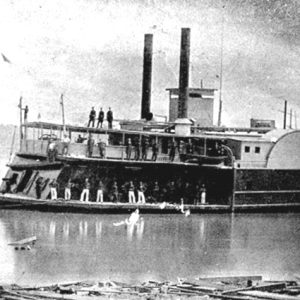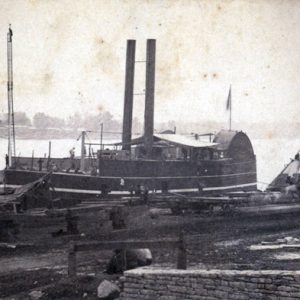calsfoundation@cals.org
Mississippi River Squadron (US)
aka: Western Gunboat Flotilla
aka: Mississippi Flotilla
aka: Mississippi Squadron
The Mississippi River Squadron was a Union military unit established in 1861 that operated vessels along the Mississippi River and its tributaries. Operating under both Federal army and navy command during the Civil War, boats of the unit saw action in and near Arkansas for much of the war.
Control of the Mississippi River was a major Union objective from the start of the war. The Anaconda Plan adopted by President Abraham Lincoln called for a naval blockade of the Confederate states and capture of the river to divide the Confederacy. Some ships could enter the mouth of the Mississippi and move up the river, but military commanders quickly recognized the need for a fleet to move down the river from northern states.
The core of the original fleet was the seven City Class ironclads constructed near St. Louis, Missouri. Designed by James Eads and Commander John Rodgers of the Union navy, these vessels were designed to operate in shallow water, were heavily armored with iron, and carried numerous pieces of artillery to engage both land targets and other boats. All of the ships were originally named for cities along western rivers.
The ironclad ships were commissioned in January 1862 and joined a number of other vessels already serving. These ships were timberclads, armored with thick planks of wood rather than iron. Flag Officer Andrew Foote served as the first commander of the squadron after it entered service, replacing Rodgers. The squadron operated as part of the Union army until September 30, 1862, when the navy took control of the vessels. The first campaign that the squadron participated in was the capture of Forts Henry and Donelson in Tennessee in February 1862.
Moving down the Mississippi River, the squadron helped capture important locations on the east bank across from Arkansas. This movement culminated in the Battle of Memphis on June 6, 1862, between the squadron and a small fleet of Confederate vessels. With the Federal victory in the battle, access to the interior rivers of Arkansas opened. Flag Officer Charles Davis commanded the squadron during this period.
The Federal Army of the Southwest under Major General Samuel Curtis moved across Arkansas after its victory at the Battle of Pea Ridge in March 1862, looking for an opportunity to capture Little Rock (Pulaski County). Low on supplies, part of the squadron ascended the White River in an effort to resupply the army. At the Engagement at St. Charles on June 17, Confederate units severely damaged the USS Mound City but were defeated by a ground assault. The mission to resupply the army eventually failed, as the two groups did not meet. This led Curtis to take Helena (Phillips County) on the Mississippi River in an effort to have better access to Union supply lines.
The major objective at this point of the war for the squadron was to wrest control of the Mississippi from Confederate forces and capture the remaining enemy strongholds located on or near the river. Rear Admiral David Dixon Porter took command of the squadron in October 1862. The squadron participated in the January 1863 capture of Fort Hindman at Arkansas Post to prevent the use of the fort to support Confederate forces at Vicksburg, Mississippi. Nine boats shelled the fort and helped force the defenders to surrender.
Confederate forces in the state launched an attack on Helena on July 4, 1863, in an effort to relieve pressure on Vicksburg. The USS Tyler participated in the successful Union defense of the city. After the Confederate defeat, Union commanders in the state captured Little Rock in September. Parts of the Arkansas River below the city were difficult to navigate, and the water level fluctuated, leading the squadron to use the White River to resupply the Federal army. Supplies would be transported to DeValls Bluff (Prairie County), where they would be transferred to trains for the journey to what is now North Little Rock (Pulaski County). Control of the lower White River was an important duty of the squadron for the remainder of the war.
Confederate units disrupted Federal supply efforts when possible and engaged isolated gunboats. The most notable instance of this type of action was the capture and sinking of the USS Queen City in Clarendon (Monroe County) by Confederate forces on June 24, 1864. Confederate attacks along the Mississippi led to the Engagement at Old River Lake on June 6, 1864.
The squadron served in the Red River Campaign in the spring of 1864, accompanying a Union army up the river in an effort to capture Shreveport, Louisiana. Falling water levels almost trapped the boats in northern Louisiana. Boats of the squadron did not support the Camden Expedition launched at the same time in Arkansas.
At the conclusion of the war, most of the ships were sold to civilian shipping companies or were scrapped. The squadron was disbanded in August 1865.
For additional information:
Anderson, Bern. By Sea and By River: The Naval History of the Civil War. New York: Alfred Knopf, 1962.
Bearss, Edwin C. “The Battle of the Post of Arkansas.” Arkansas Historical Quarterly 18 (Autumn 1959): 237–279.
Christ, Mark K. “‘The Awful Scenes That Met My Eyes’: Union and Confederate Accounts of the Battle of St. Charles, June 17, 1862.” Arkansas Historical Quarterly 71 (Winter 2012): 407–423.
Christ, Mark K., and Frederic E. Davis. “‘Them Dam’d Gunboats’: A Union Sailor’s Letters from the Arkansas Post Expedition.” Arkansas Historical Quarterly 66 (Winter 2007): 452–467.
Doyle, Daniel R. “The Civil War in the Greenville Bends.” Arkansas Historical Quarterly 70 (Summer 2011): 131–161.
Gosnell, Harpur. Guns of the Western Waters. Baton Rouge: Louisiana State University Press, 1949.
McPherson, James. War on the Waters: The Union and Confederate Navies, 1861–1865. Chapel Hill: University of North Carolina Press, 2012.
Milligan, John. Gunboats down the Mississippi. Annapolis, MD: United States Naval Institute, 1965.
Porter, David D. Naval History of the Civil War. Secaucus, NJ: Castle Books, 1984.
Sesser, David. “‘A Gallant Mail Clad Vessel’: The Capture and Sinking of the USS Queen City.” Academic Forum 25 (2008): 64–72.
David Sesser
Henderson State University
 Civil War through Reconstruction, 1861 through 1874
Civil War through Reconstruction, 1861 through 1874 Military
Military Transportation
Transportation USS Glide
USS Glide ACWSC Logo
ACWSC Logo  Battle of Arkansas Post
Battle of Arkansas Post  Mississippi River Squadron
Mississippi River Squadron  USS Mound City
USS Mound City  USS Queen City
USS Queen City  USS Tyler
USS Tyler 




Comments
No comments on this entry yet.